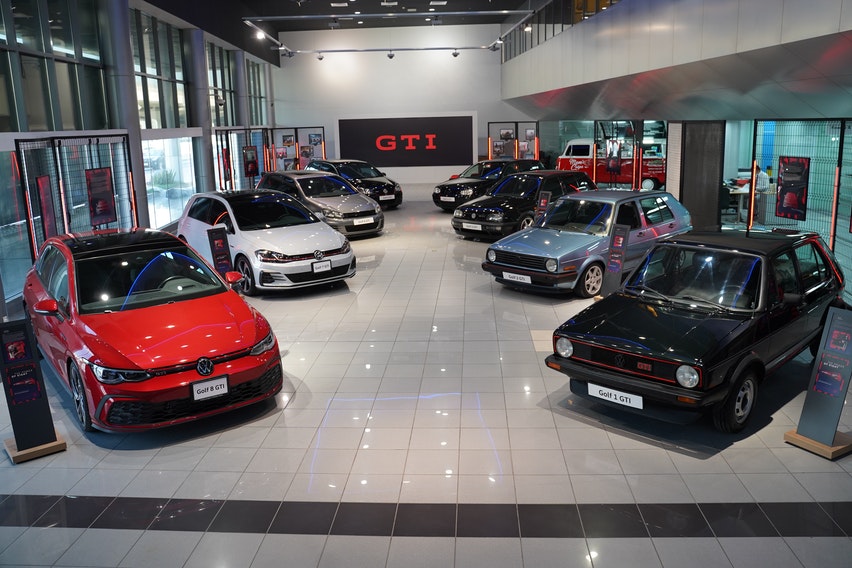Shivaum Punjabi takes a look at eight generations of the world’s most famous hot hatch.

The VW Golf GTI is a car that started a segment that auto manufactures did not know could exist. Once they knew it existed, everyone ran to make the next big hot-hatch. However, none have come close to toppling the king of the hot hatch segment, the Volkswagen Golf GTI.
VW middle east was kind enough to invite us to witness a collection that most petrolheads would love to see. Spanning over eight generations, each generation has its loyal fan base. We got to check out all eight generations under one roof at the VW showroom in Dubai. VW did all of this to celebrate 45 years of an iconic car.
I will take you through some pointers of each generation.
GEN 1 1976-1983
Many still consider the original to be the best one out there. It was also known as the “Rabbit”. FYI the first generation was built under secret from VW bosses. When they found out, they ordered a limited production run of 500 units of the car. Little did they know that it would sell beyond their expectations. In total, the car sold 461,690 units.
Due to emission norms, the US versions were slightly underpowered compared to their EU counterparts. The GTI had red accents, plaid interiors that have become signature with the car.
GEN 2 1984-1990
1984 saw the GTI grow bigger in size. Similar to the previous recipe of Gen 1, the Gen 2 had sports tuned suspension for engaging handling, 4-door and 2-door body variants. It came with a 1.8-litre engine producing 137HP. We saw the car returning with the iconic red grille trim and plaid seats/
,
GEN 3 1991-1997 cb/
The recipe remains the same. However, gone are the boxy looks and a more rounded design language has been adopted. Gone are the boxy headlights, which were replaced by a single unit roundish design. When VW launched the car, the power was 115 HP, but later in the production run, it was increased to 172 HP.
GEN 4 1998-2003
In the 2000s, we saw cars becoming softer and rounder in their appearance. We also saw the GTI get more creature comforts, making it grow in size and become easier to live with daily. The MK4 had multiple engine options, which put out 115HP to 174HP.
GEN 5 2004-2008
As design language worldwide became angular and sharper, the GTI also started getting an angular, sleeker and more aerodynamic look. Yes, the headlights were still ovalish but were more sculpted in the MK V. The signature red grille trim saw a return in this generation. This car produced 200 HP and saw the first version of the famous VW DSG dual-clutch gearbox. It also came with a multi-link independent rear suspension.
GEN 6 2009-2012
Taking cues from the MK V, the MK6 took dual lights setup and looked more aggressive. Engine output was increased to a healthy 210HP, and the car still was attached to the DSG. VW introduced an electronic limited-slip differential in the GTI versions. Also, the honeycomb design language was more pronounced and aggressive. The front and rear bumpers were redesigned to give a more aggressive look.
GEN 7 2013-2021
This is probably the most common GTI you see on the roads as it is the most current. The Gen 7 always got praised for being one of the best hot hatches of all time. The MK 7 puts out 230 HP. Visually you could identify with bigger rims and bigger brakes. It also came with multiple versions. You can spec your GTI with the Performance Pack. Or buy the Clubsport, Clubsport S or the Golf R depending on your preference.
GEN 8 2022
This is the latest iteration of the GTI. Still aggressive and rakish in design language, the honeycomb grills have become more prominent. Headlights get a new ovalish design to the previous rectangular setup. Inbuilt honeycomb fog lamps are a classy touch with a red trim straight line on the nose. There is also an LED light bar across the nose. The wheels are aerodynamic in design, and the car’s stance is low and tight. We did test drive the MK 8 version of the GTI, which you can view here down below.
Text and images by Shivaum Punjabi